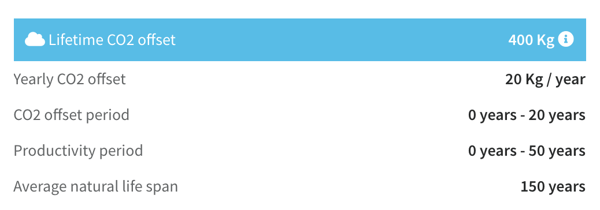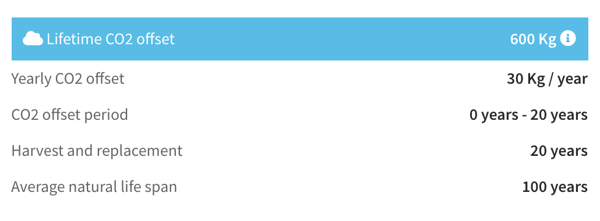Will my trees be cut?
Most of our trees are not cut and are planned to live their entire life. However, in some projects, some specific species are meant for wood production and are therefore cut when they reach adult size. Ironically it's a good thing for carbon capture.
In general, we don't plant trees to cut them. Only a limited number of species are planned to be cut when the tree reaches adult age. Those are the trees whose main benefit is the wood.
You can find this information when looking at the details of a species.
Click on any species and look at its details file. Examine if it says, 'Harvest and replacement'. This tells you if the tree is meant to cut and to be replaced. And when.
In the example below for Species 1, the mention is not visible. It means the trees of this species are not meant to be cut:

In the example below for Species 2, the mention Harvest and replacement mean this tree will be cut after 20 years and replaced by a new tree.
Is this negative for the carbon capture of the tree?
Ironically this is quite the opposite. Cutting trees, if done with the right environmental practices, can be a good thing. Obviously, with so many abuses, clear-cutting, and so much deforestation happening, it's easy to have a perception of cutting trees as purely negative. But the reality as often is the case, is more subtle.
First, trees that are grown for their wood are usually tall, large, and fast-growing trees. This means they will be able to store a very large amount of carbon and at a fast rate! After 20 years most have reached most of their carbon potential. If they stay in the forest they will indeed keep storing more carbon but at a slower rate. If they are removed, they leave space for new trees to spring.
Usually, the planters will want to plant new trees if they cut them, just because of the financial benefits linked to the wood trees. But naturally, new trees spring in a forest all the time and then often wait for a spot of light to really start their growth. They can stay in the shadow of an adult tree for some time. Then when a tree falls or is removed this opens a free space 'into the sunlight' for the baby trees to grow.
So cut trees provide a quicker replacement (than trees following a natural life) of new trees and therefore can accelerate the amount of carbon stored within the forest. Carbon capture should neither be understood as only the carbon stored in the tree trunk itself; the forest soil, with its micro life, is also a large storage of carbon that can be affected by the tree replacement cycle.
Ultimately the stock of carbon of a forest is not to be counted tree by tree. What really matters is that the forest is well managed. This is the main difference here with an initial perception that cutting trees is negative. In our projects, we care that the forest is well managed, to never clear-cut areas, and make sure of the healthy future of the forest.
Read also: What happens when a tree dies
The idea of a reforestation or afforestation project will be to increase and maximize the carbon storage capacity of the forest. In short, in terms of carbon capture, it doesn’t matter if a tree dies naturally in a forest, provided the whole forest is well managed and not being deforested. Read the full article
